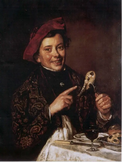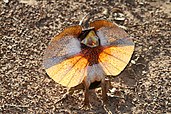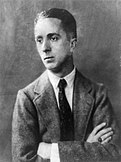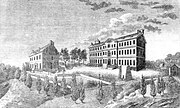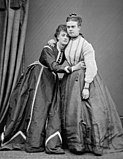Wikipedia:Today's featured article/May 2023
| << | Today's featured articles for May 2023 | >> | ||||
|---|---|---|---|---|---|---|
| Su | Mo | Tu | We | Th | Fr | Sa |
| 1 | 2 | 3 | 4 | 5 | 6 | |
| 7 | 8 | 9 | 10 | 11 | 12 | 13 |
| 14 | 15 | 16 | 17 | 18 | 19 | 20 |
| 21 | 22 | 23 | 24 | 25 | 26 | 27 |
| 28 | 29 | 30 | 31 | |||
May 1
The 2022 World Snooker Championship was a professional tournament held from 16 April to 2 May 2022 at the Crucible Theatre in Sheffield, England, its 46th consecutive year there. Broadcast by the BBC in the UK and by others elsewhere, the championship had £2,395,000 in prizes, with £500,000 for the winner. Ronnie O'Sullivan (pictured) made his 30th Crucible appearance, equalling Steve Davis's record. Reaching a record 20th quarter-final and a record 13th semi-final, O'Sullivan defeated Judd Trump 18–13 to equal Stephen Hendry's record of seven world titles. Aged 46 years and 148 days, he became the oldest world champion in snooker history, beating Ray Reardon, who was aged 45 years and 203 days in 1978. The main stage had a record 109 century breaks, with 16 by Mark Williams, who equalled Hendry's 2002 record. Neil Robertson made the 12th maximum break at the Crucible, against Jack Lisowski in the second round. Mark Selby and Yan Bingtao's 85-minute frame was the longest in Crucible history. (Full article...)
May 2
Constantine III (died 411) was a common Roman soldier who was declared emperor in Roman Britain in 407. He moved to Gaul (modern France), taking all of the mobile troops and their commander Gerontius from Britain to confront bands of Germanic invaders. Constantine stabilised the situation and established control over Gaul and Hispania (modern Spain and Portugal). Honorius, the Western Roman emperor, sent an army to expel Constantine's forces. After initial victories it was repulsed. In early 409 Honorius recognised Constantine as co-emperor. Constantine in turn raised his oldest son to co-emperor as Constans II. In 409 Gerontius rebelled, defeating and killing Constans in early 411. Meanwhile, Honorius appointed a new general, Constantius, who besieged Constantine in Arles. A relief force was ambushed and he abdicated, took holy orders and – promised his life – surrendered. Constantius had lied: Constantine was killed and his head presented to Honorius on a pole in September 411. (Full article...)
May 3

The Widows of Culloden is the twenty-eighth collection of the British designer Alexander McQueen, made for the Autumn/Winter 2006 season of his eponymous fashion house. Widows was inspired by his Scottish ancestry and is regarded as one of his most autobiographical collections. It is named for the widows of the Battle of Culloden (1746) and makes extensive use of elements taken from Highland dress, including the McQueen family tartan (pictured) and traditional gamekeeper's tweeds. The collection's runway show was staged on 3 March 2006 during Paris Fashion Week, and marked a return to theatricality for McQueen. Widows was presented on a square stage with a glass pyramid at its centre. Fifty-one ensembles were presented across roughly three phases, ending with a Pepper's ghost illusion of the English model Kate Moss projected within the glass pyramid. Critical response was positive, especially towards McQueen's tailoring and the collection's balance of artistry and commercial practicality. (Full article...)
May 4
Lego Star Wars II: The Original Trilogy is a 2006 Lego-themed action-adventure video game developed by Traveller's Tales and published by LucasArts and TT Games Publishing. Part of the Lego Star Wars series, it is based on the Star Wars media franchise and the Lego Group's Star Wars–themed toy line. It follows the events of the first three Star Wars films to be released: A New Hope, The Empire Strikes Back and Return of the Jedi. The game allows players to assume the roles of over fifty Lego versions of characters from the series. Camera movement was improved from its predecessor Lego Star Wars: The Video Game. Lego Star Wars II was critically and commercially successful; it sold over 8.2 million copies worldwide. Critics praised the game for its comedic portrayal of the film series, which some described as "adorable". The game's low difficulty, and its handheld versions in general, were received more poorly. The game won a British Academy Games Award and a Spike Video Game Award. (Full article...)
May 5
The Badge Man is a figure said to be present within a photograph taken by Mary Moorman of the assassination of John F. Kennedy on November 22, 1963, captured a fraction of a second after a bullet struck Kennedy's head. Such a person is not present in any other photographs of the assassination and was not seen by any witnesses. Much of the detail is obscured, some believe by a muzzle flash. The moniker derives from a bright spot on what is deemed the figure's chest, said to resemble a gleaming badge. The photograph was analyzed by the House Select Committee on Assassinations, but no evidence of hidden figures was found. However, in 1983, Gary Mack—the curator of the Sixth Floor Museum—obtained a higher quality copy of the photograph. Upon enhancement, Mack noted what he believed to be the Badge Man in the shadowed background. Conspiracy theorists have suggested that this figure is a sniper or a man in police uniform, and believe it to be a second assassin, firing at Kennedy from the grassy knoll. (Full article...)
May 6
Edward I (1239–1307) was King of England from 1272 until his death. Involving himself politically under the reign of his father Henry III, Edward briefly sided with a baronial reform movement. After reconciliation with Henry III, Edward defeated the barons by 1267 and set out to the Holy Land on a crusade in 1270. On his return journey, Edward learned of his father's death; the new king returned to England in 1274 and was crowned in Westminster Abbey. Edward spent his reign reforming English currency and pushing through major legislative reform, in addition to involving himself in conflict with France. Edward conquered Wales and intended to likewise take over Scotland; this ultimately failed. Upon his death, he was succeeded by his son Edward II. Edward has been considered one of the greatest medieval English kings for the achievements of his reign, but some historians have criticised him for his brutal military campaigns and for expelling English Jews. (Full article...)
May 7
The New Amsterdam Theatre is a Broadway theater on 214 West 42nd Street, in the Theater District of Manhattan in New York City. It was one of the first Broadway venues to open in the Times Square neighborhood, on October 26, 1903. The theater has 1,702 seats across three levels. Both the Beaux-Arts exterior and the Art Nouveau interior of the building are New York City landmarks, and the building is on the National Register of Historic Places. The New Amsterdam consists of an auditorium in the rear and a narrow ten-story office wing in the front. The facade on 42nd Street is made of gray limestone; the rest of the facade is brick. The elliptical auditorium contains two balconies cantilevered above a ground-level orchestra. Above the main auditorium was a roof theater. The main theater has a steel frame and was designed with advanced mechanical systems for its time. It is operated by Disney Theatrical Productions and has hosted the musicals The Lion King, Mary Poppins and Aladdin. (Full article...)
May 8

Julian of Norwich (c. 1343 – after 1416) was an English mystic and anchoress of the Middle Ages. She lived in the English city of Norwich. During her lifetime, the city suffered the devastating effects of the Black Death, the Peasants' Revolt, and the suppression of the Lollards. In 1373, believing she was on her deathbed, Julian received a series of visions ("shewings") of the Passion of Christ. She recovered and wrote two versions of her experiences. These, now known as Revelations of Divine Love, are the earliest surviving English-language works known to have been written by a woman, and the only surviving English-language works by an anchoress. Julian lived in permanent seclusion in her cell, which was attached to St Julian's Church, Norwich. Details of Julian's family, her education, or her life before becoming an anchoress are not known. Preferring to write anonymously, she was nevertheless influential in her lifetime. (Full article...)
May 9
The government of ancient Macedonia was first established sometime during the 8th–5th centuries BC. Little is known of its institutions before the reign of Philip II (depicted), from 359 to 336 BC. Administration evolved in complexity under his successor Alexander the Great and subsequent dynasties. It is unclear if a constitution was formally established. The king (basileus) served as the head of state, assisted by his noble companions and royal pages. Kings served as chief judges and high priests of the nation, using their wealth to sponsor religious cults and to fund the armed forces. They controlled the exploitation of gold and timber. The right to mint coins was shared by the central and some local governments. The kings were the commanders-in-chief of the armed forces and commonly led their troops into battle. The ancient Macedonian army held some of the functions of a popular assembly and had some authority over the royal succession. In 167 BC the Macedonian monarchy was abolished and replaced by four Roman client states. (Full article...)
May 10
Alexis Soyer (1810–1858) was a French chef, writer and inventor, who made his reputation in Victorian England. He worked in the kitchens of royalty, the aristocracy and the landed gentry until 1837. He was then appointed head chef of the Reform Club, where he designed the kitchens on radical modern lines and became celebrated for the range and excellence of his cooking. Soyer became a well-known author of cookery books, aimed variously at the grand kitchens of the aristocracy, at middle-class households and at the poorest families, whose diet he strove to improve. He published recipes for inexpensive and nutritious food and took a keen interest in public health. During the Irish potato famine he set up a soup kitchen in Dublin. During the Crimean War Soyer travelled to the front and worked with Florence Nightingale to improve conditions for the troops. He invented the portable Soyer stove which remained in army use for more than a century. In 1858 he died of a stroke. (Full article...)
May 11
Judy Ann Santos (born May 11, 1978) is a Filipino actress and film producer. She is a recipient of two Luna Awards, three FAMAS Awards, a Gawad Urian, and a Cairo International Film Festival Award. At age ten, she had her breakthrough as the title character in the children's television show Ula, Ang Batang Gubat (1988). Santos became more recognized as a leading actress in primetime with starring roles in the series Mara Clara (1992) and Esperanza (1997). She received critical acclaim as a woman with dissociative identity disorder in the psychological drama Sabel (2004), which won her a Gawad Urian for Best Actress. Among her highest-grossing films are the comedy Kasal, Kasali, Kasalo (2006) and its sequel Sakal, Sakali, Saklolo (2007). Santos co-produced Ploning (2008) and starred in Mindanao (2019), which were submissions for Best International Feature Film at the Academy Awards. Outside of acting, she is also a chef and a restaurateur. (This article is part of a featured topic: Overview of Judy Ann Santos.)
May 12
The Battle of Raymond was fought on May 12, 1863, near Raymond, Mississippi, during the Vicksburg campaign of the American Civil War. In late April, Union general Ulysses S. Grant led his army across the Mississippi River and moved east. A portion of the army led by James B. McPherson moved towards Raymond. Confederate brigadier general John Gregg was ordered from Jackson to Raymond. The two forces met on the morning of May 12. Gregg underestimated Union strength and acted aggressively, while McPherson overestimated Confederate strength and responded cautiously. Early on, the battle was relatively evenly matched. McPherson brought up reinforcements and the weight of Union numbers cracked the Confederate line. Gregg disengaged, but McPherson did not pursue. The battle changed Grant's plans, leading him to first focus on the Confederate forces at Jackson. Grant's men captured Jackson and pivoted west. They besieged Vicksburg, which the Confederates were forced to surrender on July 4. (Full article...)
May 13
The frilled lizard (Chlamydosaurus kingii) is a species in the family Agamidae. It is native to northern Australia and southern New Guinea. It is the only member of the genus Chlamydosaurus. Its common name comes from its large neck frill, usually folded against the lizard's body. It is about 90 cm (35 in) in length and can weigh 600 g (1.3 lb). Males are larger and more robust than females. The lizard is generally grey, brown, orangish-brown, or black. The frills have red, orange, yellow, or white colours. The lizard is largely arboreal, and its diet is mainly insects and other invertebrates. It is more active during the wet season, when it spends more time near or on the ground. In the dry season, it seeks shade in the branches of the upper canopy. It breeds in the late dry season and early wet season. The lizard uses its frill to scare off predators and to display to other individuals. The species is considered to be of least concern by the International Union for Conservation of Nature. (Full article...)
May 14
Marriage License is an oil painting by American illustrator Norman Rockwell (pictured) created for the cover of the June 11, 1955, edition of The Saturday Evening Post. It depicts a young man and woman filling out a marriage license application at a government building in front of a bored-looking clerk. Although the room and its furnishings are dark, the couple are illuminated by the window beside them. The contrast between the couple and the clerk highlights two reoccurring themes in Rockwell's works: young love and ordinary life. The painting has been praised by critics and compared to the works of Johannes Vermeer due to the use of light and dark. The painting is in the Norman Rockwell Museum's collection and has been a part of major exhibitions in 1955, 1972, and 1999. In 2004 the magazine Mad published a parody of Marriage License that depicted a pair of gay men, seen as a commentary on competing meanings of marriage and the government's role in deciding whether same-sex marriage is valid. (Full article...)
May 15
Enoch Fenwick (May 15, 1780 – November 25, 1827) was an American Catholic priest and Jesuit, who ministered throughout Maryland and became the president of Georgetown College in Washington, D.C. Born in Maryland, he studied at Georgetown College (pictured). Like his brother, future bishop Benedict Joseph Fenwick, he entered the priesthood, studying at St. Mary's Seminary before entering the Society of Jesus, which was suppressed at the time. He became the rector of St. Peter's Pro-Cathedral in Baltimore for ten years, and was briefly also the vicar general of the Archdiocese of Baltimore. In 1820, Fenwick reluctantly accepted his appointment as the president of Georgetown College. While he made some improvements to the curriculum, his presidency was considered unsuccessful by contemporaries due to declining enrollment and mounting debt. In August 1825, he abandoned the presidency following a disagreement with the provincial superior. Two years later, he died at Georgetown College. (Full article...)
May 16
"Paint It Black" is a song by the Rolling Stones (pictured), recorded in 1966 and released as a single in May. Two months later, London Records included it as the opening track on the American version of the band's studio album Aftermath. The song's unconventional instrumentation includes a prominent sitar, a Hammond organ, and castanets. Reviews at the time were mixed. Some music critics believed the sitar was used to attempt to copy the Beatles; others criticised its experimental style and doubted its commercial potential. Retrospectively, however, it is considered a turning point in the band's development; Pitchfork called it "rock's most nihilistic hit to date". It spent 11 weeks (including 2 at number one) on the US Billboard Hot 100, and 10 weeks (including 1 at the top) on the UK Record Retailer chart. A 2007 re-issue spent 11 weeks on the UK Singles Chart. Inducted into the Grammy Hall of Fame in 2018, the song is ranked 213th on Rolling Stone's 500 Greatest Songs of All Time list. (Full article...)
May 17

Hajj: Journey to the Heart of Islam was an exhibition held at the British Museum in London from 26 January to 15 April 2012. It was the world's first major exhibition telling the story, visually and textually, of the hajj: the pilgrimage to Mecca which is one of the five pillars of Islam. Textiles, manuscripts, historical documents, photographs, and art works from many different countries and eras were displayed to illustrate the themes of travel to Mecca, hajj rituals, and the Kaaba (depicted). The exhibition was formally opened by the then Prince Charles and was popular both with Muslims and non-Muslims, attracting nearly 120,000 adult visitors and favourable press reviews. An exhibition catalogue with essays about the hajj was published by the British Museum in 2012, along with a shorter illustrated guide to the hajj. An academic conference, linked to the exhibition, resulted in another book about the topic. (Full article...)
May 18
Apollo 10 (May 18–26, 1969) was the fourth crewed mission in the United States Apollo program, and the second to orbit the Moon. NASA described it as a "dress rehearsal" for the first Moon landing, and designated it an "F" mission. While John Young remained in the Command and Service Module orbiting the Moon, Tom Stafford and Gene Cernan flew the Apollo Lunar Module (pictured) to within 14.4 kilometers (7.8 nmi) of the lunar surface, the point at which powered descent for landing would begin on a landing mission, before rejoining Young in the Command and Service Module. While in the Lunar Module, Stafford and Cernan photographed the site where Apollo 11 would land two months later. After orbiting the Moon 31 times over 61.6 hours, Apollo 10 returned safely to Earth, setting a record that still stands for the highest velocity achieved by a crewed spacecraft. Both Young and Cernan would walk on the Moon later in the Apollo program; Stafford flew again in 1975 on Apollo–Soyuz. (Full article...)
May 19
Witchfinder General is a 1968 British period horror film directed by Michael Reeves. The screenplay, by Reeves and Tom Baker, was based on Ronald Bassett's novel Witchfinder General. The plot follows Roundhead soldier Richard Marshall, played by Ian Ogilvy, who pursues witchfinder general Matthew Hopkins, played by Vincent Price (pictured), and his assistant John Stearne, played by Robert Russell. The low-budget film was produced by Tigon British Film Productions. In the United States, the film was retitled The Conqueror Worm by its distributor American International Pictures to link it with their earlier series of Edgar Allan Poe adaptations. Witchfinder General became a cult film, partially attributable to Reeves's death nine months after its release. Critics' praise for the film highlighted its direction, performances, and musical score by Paul Ferris. In 2005, the magazine Total Film named Witchfinder General the 15th-greatest horror film of all time. (Full article...)
May 20
Hoodening is a folk custom found in Kent, a county in south-eastern England. The tradition entails the use of a wooden hobby horse, known as a "hooden horse", that is mounted on a pole and carried by an individual hidden under a sackcloth. It represents a regional variation of a hooded animal tradition that appears throughout the British Isles. As recorded from the eighteenth to the early twentieth centuries, hoodening was performed at Christmas time by groups of farm labourers who would form into teams to accompany the hooden horse on its travels. These often included an individual to carry the horse, another to lead the horse, a man in female clothing known as a "Mollie", and several musicians. The team would then carry the horse to local houses and shops, where they would expect payment for their appearance. Although this practice is now extinct, the hooden horse is still incorporated into various Kentish Mummers' plays and Morris dances that take place at different times of the year. (Full article...)
May 21
The capture of Wakefield occurred on 21 May 1643 during the First English Civil War when around 1,500 Parliamentarians under the command of Sir Thomas Fairfax (depicted) attacked the Royalist garrison of Wakefield, Yorkshire. They were outnumbered by around 3,000 Royalists led by George Goring, but successfully stormed the town. Around 800 Parliamentarians had been taken prisoner after Fairfax was defeated at Seacroft Moor, and he planned the attack to take prisoners of his own to exchange for his men. He marched his force from Leeds and divided it to attack from two different directions. After around two hours of fighting early in the morning, they broke into the town. Goring, who had been in bed suffering from either illness or a hangover, led a counterattack in his nightshirt, but to no avail. Fairfax took roughly 1,400 prisoners while, according to his own account, losing no more than seven men. (Full article...)
May 22
Shefali Shah (born 22 May 1973) is an Indian actress who appears in Hindi films. Respected for her acting prowess, she has received multiple accolades, including a National Film Award and two Filmfare Awards. Shah's acting career started on the Gujarati stage before she debuted on television in 1993. She gained wider recognition in 1997 for her role in the popular series Hasratein. A supporting role in Satya (1998) started her focus on film work, mostly in character parts and often to appreciation from critics, including in the drama The Last Lear (2007). Shah's career surged in the late 2010s as she transitioned to leading roles, including in two Netflix projects: the romantic drama Once Again (2018) and the International Emmy Award–winning miniseries Delhi Crime (2019). Shah wrote and directed two short films in 2020: Someday and Happy Birthday Mummyji. She gained further recognition with five projects in 2022. (Full article...)
May 23
The Playboy is a graphic novel by Canadian cartoonist Chester Brown (pictured), serialized in 1990 in his comic book Yummy Fur and collected in different revised book editions in 1992 and 2013. It deals with Brown's guilt and anxiety over his obsessive masturbation to Playboy Playmate models; out of fear of being caught, he repeatedly rids himself of copies of the magazine, only to retrieve them later. His conflicting emotions follow him into adulthood until he purges them by revealing himself through his comics. The free, organic arrangement of odd-shaped panels of simple, expressive artwork contrasts with his more detailed grid-like pages in his 1980s work, such as Ed the Happy Clown. The Playboy forms part of Brown's autobiographical period during the early 1990s, and was the first book-length work he planned as a complete story. It has attracted praise for its revealing honesty, and criticism from those who saw it as glorifying pornography. (Full article...)
May 24

The eye is a region of mostly calm weather found at the center of tropical cyclones and is a well-recognized feature. It is usually circular, typically 30–65 kilometers (19–40 miles) in diameter and is at the cyclone's center of circulation. A cyclone's lowest barometric pressure occurs in the eye, and can be as much as 15 percent lower than the pressure outside the storm. In strong tropical cyclones, the eye is characterized by light winds and clear skies, surrounded on all sides by an eyewall, a normally symmetric ring of towering thunderstorms where the most severe weather of a cyclone occurs. In weaker tropical cyclones, the eye is less well defined, and can be covered by the central dense overcast, an area of high, thick clouds that show up brightly on satellite imagery. Weaker or disorganized storms may also feature an eyewall that does not completely encircle the eye, or have an eye that features heavy rain. (Full article...)
May 25
Bennerley Viaduct is a former railway bridge, now a foot and cycle bridge, in central England, between the town of Ilkeston, Derbyshire, and the village of Awsworth, Nottinghamshire. It was completed in 1877 and opened in 1878 to carry the Great Northern Railway's Derbyshire Extension over the valley of the River Erewash. The site required a bespoke design as the ground would not support a traditional masonry structure. The viaduct consists of 16 spans of lattice truss girders made of wrought iron, carried on 15 wrought-iron piers supported by brick and ashlar bases. It is 60 feet (18 m) high, 26 feet (7.9 m) wide between the parapets, and over a quarter of a mile (400 metres) long. It was once part of a chain of bridges and embankments carrying the railway for 2 miles (3 km) across the valley. Its working life was uneventful except for minor damage inflicted by a Zeppelin bombing raid during World War I. It opened to the public as part of a cycling and walking route in January 2022. (Full article...)
May 26
A History of British Fishes is a natural history book by William Yarrell, serialised in 19 parts from 1835, and then published bound in two volumes in 1836. It is a handbook describing every type of fish then known to occur in the British Isles. Yarrell was a London bookseller and newsagent with the time and income to indulge his interest in natural history. He was a prominent member of several natural history societies, had an extensive library and collection of specimens, and a wide network of naturalist friends who helped him garner material for his writings, notably his book on fishes and the 1843 A History of British Birds. He followed Thomas Bewick's example with up-to-date data, accurate illustrations, and detailed descriptions. The woodcut illustrations were drawn by Alexander Fussell, engraved by John Thompson, and published by John Van Voorst. Yarrell died in 1856; the third edition was produced posthumously. The book was a commercial success and became a standard reference work. (Full article...)
May 27
The black-and-yellow broadbill (Eurylaimus ochromalus) is a species of bird in Eurylaimidae, the typical broadbill family. It is small, with a black head, breastband, and upperparts, a white neckband, yellow streaking on the back and wings, and wine-pink underparts that turn yellow towards the belly. The beak is bright blue, with a green tip to the upper mandible and black edges. The black breastband is incomplete in females. The black-and-yellow broadbill occurs in Brunei, Indonesia, Malaysia, Myanmar, Singapore, and Thailand, in lowland forests up to an elevation of 1,220 m (4,000 ft). It is mainly insectivorous, but also eats molluscs and some fruit. It breeds during the dry season with both sexes helping build a large, untidy nest from moss, fungal mycelia, and leaves. The clutch is usually 2–3 eggs, and sometimes includes a fourth runt egg. They are incubated by both sexes. The species is listed as near-threatened by the IUCN due to a decline in its population caused by habitat loss. (Full article...)
May 28
The 2018 EFL League Two play-off final was an association football match played on 28 May 2018 at Wembley Stadium (pictured), London, between Coventry City F.C. and Exeter City F.C. The match determined the fourth and final team to gain promotion from EFL League Two, English football's fourth tier, to EFL League One; the top three teams of the 2017–18 EFL League Two season were automatically promoted to the 2018–19 EFL League One. Teams placed from fourth to seventh in the table took part in play-off semi-finals, with the winners of these semi-finals competing for the final place. Coventry won the match 3–1. Coventry opened the scoring through Jordan Willis, followed by two more goals from Jordan Shipley and Jack Grimmer. Exeter had a consolation goal in the last minutes of the match, thanks to a curled strike from Kyle Edwards. Coventry earned their first promotion since 1967, with Marc McNulty, their striker, being named the man of the match. (Full article...)
May 29
Paint Drying is a 2016 British experimental protest film that was produced, directed and shot by Charlie Shackleton. He created the film in protest against film censorship in the United Kingdom and the sometimes-prohibitive cost to independent filmmakers that the classification requirement of the British Board of Film Classification (BBFC) imposes. The film consists of 607 minutes (10 hours and 7 minutes) of an unchanging view of white paint drying on a brick wall (similar wall pictured). Shackleton made the film to force the BBFC to watch it in its entirety to give the film an age rating classification. Shackleton initially shot 14 hours' worth of footage of paint drying in 4K resolution and opened a Kickstarter campaign to pay the BBFC's per-minute rate for a film as long as possible. It raised £5,936 from 686 backers, paying for a film lasting 10 hours and 7 minutes. After reviewing the film, the BBFC rated it "U" for "Universal", indicating "no material likely to offend or harm". (Full article...)
May 30
Ignace Tonené (1840 or 1841 – 1916) was the chief of the Teme-Augama Anishnabai, an Indigenous nation in Ontario. He was a fur trader and a gold prospector who was a prominent employee of the Hudson's Bay Company. Tonené was elected the deputy chief before being the lead chief and later the life chief of his community. In his role as deputy, he negotiated with the Canadian federal government and the Ontario provincial government, advocating for his community to receive annual financial support from both. His attempts to secure land reserves for his community were thwarted by Ontario premier Oliver Mowat. Tonené's gold prospecting triggered a 1906 staking rush and the creation of the Kerr Addison gold mine. One of his claims over the gold was stolen from him by white Canadian prospectors. He died near Lake Abitibi, Quebec, and was buried close to Mount Kanasuta. In 2016, Tournene Lake in the Timiskaming District of Ontario was renamed as Chief Tonene Lake. (Full article...)
May 31
Boulton and Park, two Victorian homosexuals from upper-middle-class English families, were cross-dressers and enjoyed playing the women's roles in theatrical performances. Lord Arthur Clinton, Member of Parliament for Newark, entered into a relationship with Boulton. Boulton and Park were arrested in 1870 after leaving a London theatre in drag. They were still in women's dresses the next morning when they appeared in court, where hundreds had gathered. Boulton and Park were charged with conspiracy to commit sodomy, a crime that carried a maximum prison sentence of life with hard labour. They were found not guilty after the prosecution failed to establish that they had anal sex. The judge, Sir Alexander Cockburn, was highly critical of the police investigation. Boulton and Park admitted to appearing in public dressed as women, which was "an offence against public morals and common decency". They were bound over for two years. The case was reported in all the major newspapers, much of it in lurid terms. (Full article...)







